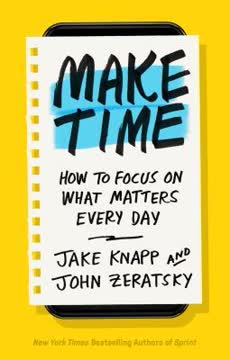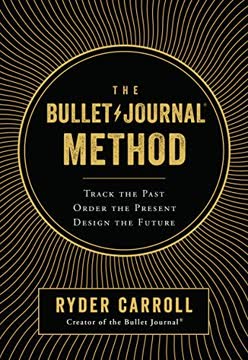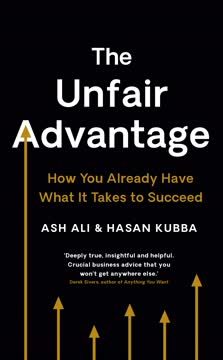Key Takeaways
1. Capture everything that has your attention
Your mind is for having ideas, not for holding them.
Clear your mind. Capture all thoughts, ideas, and commitments that occupy your mental space. This includes tasks, projects, information, and even vague notions that nag at you. Use tools like notepads, digital recorders, or smartphone apps to externalize these items.
Create a collection habit. Place capture tools in strategic locations:
- Notepads by every phone
- Whiteboards in thinking spaces
- A physical in-basket on your desk
- A notes app on your smartphone
By consistently capturing everything, you free your mind from the burden of remembering, allowing it to focus on more creative and productive thinking.
2. Clarify the meaning of captured items
If you haven't clarified exactly what your commitment is and decided what you're going to do about it, it will often be a source of frustration and stress.
Process your captures. For each item you've collected, ask yourself:
- What is it?
- Is it actionable?
- What's the next action?
- What's the desired outcome?
Make decisions. Clarifying involves making choices about the significance and future of each item. This process transforms vague notions into concrete next steps or eliminates them entirely if they're no longer relevant.
- Actionable items become tasks or projects
Non-actionable items are:- Trashed
- Filed as reference
- Incubated for later consideration
By clarifying, you convert raw data into meaningful, actionable information, reducing ambiguity and stress in your system.
3. Organize your commitments into a trusted system
Your mind is for having ideas, not for holding them.
Create a structured system. Organize your clarified items into appropriate categories:
- Next Actions (context-based lists like @calls, @computer, @errands)
- Projects (outcomes requiring multiple steps)
- Waiting For (items delegated or dependent on others)
- Calendar (date-specific and time-specific actions)
- Reference (non-actionable but potentially useful information)
Use appropriate tools. Choose organizing tools that work for you:
- Physical: File folders, notebooks, planners
- Digital: Task management apps, note-taking software, calendar apps
The key is to have a system you trust completely. When you know everything is in its right place, your mind can relax and focus on the task at hand rather than trying to remember everything.
4. Regularly review and update your system
Your mind is like water. When it's turbulent, it's difficult to see. When it's calm, everything becomes clear.
Weekly review. Set aside time each week to:
- Get clear: Gather all loose papers, notes, and items
- Get current: Review and update your lists and calendar
- Get creative: Think big picture and generate new ideas
Mind like water. The weekly review helps maintain a clear, uncluttered mind. Like water, your mind should be able to respond appropriately to any input without overreacting or underreacting.
Benefits of regular review:
- Ensures nothing falls through the cracks
- Keeps your system current and relevant
- Provides a sense of control and perspective
- Allows for course corrections and adjustments
By consistently reviewing and updating your system, you maintain its integrity and your trust in it, leading to reduced stress and increased productivity.
5. Take action on your tasks and projects
The secret of getting ahead is getting started. The secret of getting started is breaking your complex overwhelming tasks into small manageable tasks, and then starting on the first one.
Engage with your system. Once you have a clear, organized system, the final step is to actually do the work. Use your next actions lists to guide your daily activities.
Two-minute rule. If an action takes less than two minutes, do it immediately rather than adding it to your list. This prevents small tasks from clogging your system.
Factors to consider when choosing actions:
- Context: What can you do in your current location?
- Time available: How much time do you have right now?
- Energy level: What are you capable of doing at this moment?
- Priority: What's the most important thing to do right now?
By consistently taking action on your tasks and projects, you make progress towards your goals and maintain momentum in your personal and professional life.
6. Define your purpose and principles
If you don't know why you exist or where you are going, any road, indeed, will do.
Clarify your purpose. Consider the fundamental question: "Why am I (or are we) doing this?" This applies to your life, your work, and any significant project or endeavor.
Establish principles. Identify the core values and standards that guide your behavior and decision-making. These serve as a compass for navigating complex situations.
Examples of personal principles:
- Honesty and integrity in all interactions
- Continuous learning and self-improvement
- Balance between work and personal life
- Environmental responsibility
By defining your purpose and principles, you create a foundation for making aligned decisions and living a more fulfilling life.
7. Establish a clear vision for your life and work
The future is not some place we are going, but one we are creating. The paths are not to be found, but made.
Create a compelling vision. Imagine your ideal future in vivid detail. What does success look, sound, and feel like for you? This vision serves as a north star, guiding your decisions and actions.
Make it tangible. Write down your vision or create a visual representation:
- Vision statements
- Vision boards
- Detailed scenarios of your ideal future
A clear vision provides motivation and direction, helping you make decisions that align with your long-term aspirations. It also serves as a filter for opportunities, allowing you to focus on what truly matters to you.
8. Set goals and objectives to achieve your vision
You can only feel good about what you're not doing when you know what you're not doing.
Define specific outcomes. Break down your vision into concrete, achievable goals. These should be SMART:
- Specific
- Measurable
- Achievable
- Relevant
- Time-bound
Create a goal hierarchy. Organize your goals into different time frames:
- Long-term goals (3-5 years)
- Medium-term goals (1-2 years)
- Short-term goals (3-6 months)
By setting clear goals and objectives, you create a roadmap for turning your vision into reality. This allows you to focus your energy and resources on what's most important, increasing your chances of success.
9. Identify areas of focus and responsibility
What we focus on expands. What we think about, becomes more important to us.
Define key areas. Identify the major categories of your life and work that require ongoing attention and management. These might include:
- Career
- Finances
- Health and fitness
- Relationships
- Personal growth
- Home environment
Maintain balance. Regularly assess these areas to ensure you're not neglecting important aspects of your life. This holistic approach prevents tunnel vision and promotes overall well-being.
By clearly defining your areas of focus and responsibility, you create a framework for balanced personal and professional development. This helps you allocate your time and energy more effectively across all important aspects of your life.
10. Maintain perspective across all horizons of focus
Perspective is worth 80 IQ points.
Understand the horizons. Familiarize yourself with the six horizons of focus:
- Ground level: Current actions
- 10,000 feet: Current projects
- 20,000 feet: Areas of responsibility
- 30,000 feet: 1-2 year goals
- 40,000 feet: 3-5 year vision
- 50,000 feet: Life purpose
Regular review. Periodically assess your commitments and activities at each level. This ensures alignment between your day-to-day actions and your highest aspirations.
Maintaining perspective across all horizons allows you to make better decisions, stay motivated, and feel confident that you're on the right track. It helps you balance short-term needs with long-term goals, leading to a more fulfilling and purposeful life.
11. Implement effective tools and habits to support your system
Your brain is for having ideas, not holding them.
Choose the right tools. Select tools that support your workflow:
- Physical tools: Notebooks, file cabinets, in-trays
- Digital tools: Task managers, note-taking apps, calendar software
Develop supportive habits. Create routines that reinforce your system:
- Daily review of your calendar and next actions
- Weekly review of your entire system
- Regular capture of new inputs
Key habits to cultivate:
- Ubiquitous capture
- Immediate clarification of new inputs
- Consistent use of your organizational system
- Regular review and update of your commitments
By implementing effective tools and habits, you create a robust infrastructure that supports your productivity system. This makes it easier to maintain the system over time, leading to sustained improvements in productivity and reduced stress.
Last updated:
FAQ
What's Making It All Work about?
- Self-Management Focus: The book emphasizes self-management in both personal and professional contexts, building on principles from Allen's previous work, Getting Things Done.
- GTD Methodology: It introduces the GTD methodology, which includes capturing, clarifying, organizing, reflecting, and engaging with tasks and commitments.
- Integration of Life and Work: Allen argues that mastering both work and life requires understanding and applying the same principles across various aspects of life.
Why should I read Making It All Work?
- Practical Guidance: Offers practical advice and techniques to improve productivity and reduce overwhelm.
- Deeper Understanding of GTD: Provides a deeper understanding of the GTD principles and addresses common pitfalls.
- Holistic Approach: Encourages a holistic view of life, integrating personal and professional responsibilities for a balanced life.
What are the key takeaways of Making It All Work?
- Control and Perspective: Success requires a balance between control and perspective for effective self-management.
- Five Stages of Control: Capturing, clarifying, organizing, reviewing, and engaging are crucial for managing tasks effectively.
- Six Horizons of Focus: These horizons help assess commitments and priorities, from daily actions to long-term goals.
What is the GTD methodology in Making It All Work?
- Five Stages of Processing: The GTD method involves capturing, clarifying, organizing, reflecting, and engaging with tasks.
- Capturing Everything: The first step is to capture everything that has your attention to clear mental clutter.
- Clarifying Actions: After capturing, clarify what each item means and what action is required.
How do I implement the capturing stage from Making It All Work?
- Mind Sweep Technique: Conduct a "mind sweep" to write down everything that has your attention.
- Use of Tools: Utilize tools like notepads or digital apps to capture thoughts as they come.
- Regular Review: Make capturing a regular habit to stay on top of commitments and reduce overwhelm.
What are the six horizons of focus in Making It All Work?
- Next Actions (Runway): Focuses on specific tasks that need immediate completion.
- Projects (Ten Thousand Feet): Encompasses projects requiring multiple steps to complete.
- Areas of Focus (Twenty Thousand Feet): Includes key areas of responsibility like health and career.
How does Making It All Work help with time management?
- Structured Approach: Breaks down tasks into actionable steps to prioritize effectively.
- Weekly Reviews: Emphasizes conducting weekly reviews to assess progress and adjust priorities.
- Focus on Next Actions: Identifying next actions helps make better use of time and reduces wasted time.
What are some best practices for clarifying tasks in Making It All Work?
- Determine Actionability: Assess whether each item is actionable and decide on the next action.
- Use Clear Questions: Ask “What’s my desired outcome?” and “What’s the next action?” to stay focused.
- Avoid Overthinking: Focus on the immediate next step to maintain momentum and prevent procrastination.
What are some common pitfalls in implementing GTD from Making It All Work?
- Neglecting the Clarifying Stage: Failing to clarify tasks can lead to confusion and lack of progress.
- Overcomplicating the System: Creating overly complex systems can be difficult to maintain.
- Failing to Review Regularly: Without regular reviews, it’s easy to lose track of commitments and priorities.
What are the best quotes from Making It All Work and what do they mean?
- “The art of progress...”: Emphasizes balancing structure with adaptability to achieve success.
- “Your mind is for having ideas...”: Encourages capturing thoughts externally to manage commitments effectively.
- “Clarity is self-created.”: Suggests individuals have the power to define their own clarity and direction.
How can I maintain control and perspective in my life, according to Making It All Work?
- Regularly Review Commitments: Conduct regular reviews to ensure commitments remain relevant and aligned with goals.
- Use the Horizons of Focus: Engage with the six horizons to assess responsibilities and prioritize effectively.
- Stay Flexible and Adaptable: Be prepared to adjust plans and priorities as circumstances change.
What is the importance of reflection in Making It All Work?
- Enhances Perspective: Reflection helps assess situations from a broader perspective and identify areas for improvement.
- Informs Decision-Making: Provides insights that inform decision-making and help evaluate action effectiveness.
- Promotes Continuous Improvement: Identifying patterns through reflection fosters personal and professional growth.
Review Summary
Making It All Work is a follow-up to David Allen's "Getting Things Done" (GTD) system. Readers find it helpful in expanding on GTD principles, particularly regarding long-term goals and perspectives. Some appreciate the clarification of concepts, while others feel it's redundant. The book is most beneficial for those already familiar with GTD, offering insights on aligning tasks with larger objectives. Critics note its wordiness and philosophical approach. Many readers value the appendices and find the book useful for refocusing on productivity. Overall, it's seen as a worthy companion to GTD, though not essential for everyone.
Similar Books










Download PDF
Download EPUB
.epub digital book format is ideal for reading ebooks on phones, tablets, and e-readers.








